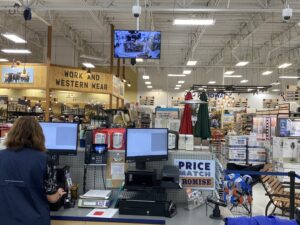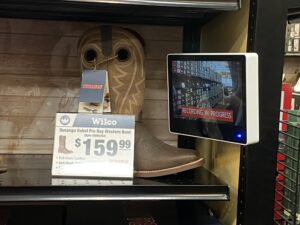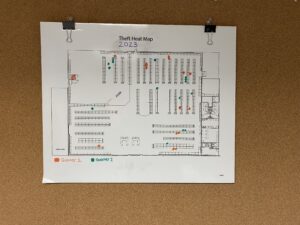Costing businesses money and peace of mind, shrink takes a toll on the retail industry, especially on independently owned and small- and medium-size businesses. The National Retail Federation’s (NRF) National Retail Security Survey 2022 discovered retail shrink, which includes organized retail crime (ORC), was nearly a $100 billion problem across all industries in 2022. The survey results found retail theft accounted for 37% of those losses, employee or internal theft made up 29% and the remaining 34% came from process and control failures and other types of theft and fraud.
 Every time an individual enters a store with the intent to steal, they put employees and other customers in harm’s way, making retail shrink more than just a financial problem. In the NRF study, 80% of retailers reported an increase in violence and aggression associated with ORC.
Every time an individual enters a store with the intent to steal, they put employees and other customers in harm’s way, making retail shrink more than just a financial problem. In the NRF study, 80% of retailers reported an increase in violence and aggression associated with ORC.
Despite the risks and negative effects of retail crimes, many retailers lack an effective loss prevention plan. Fortunately, taking small steps and creating simple loss prevention procedures can make a significant difference.
At Wilco Stores, which has 26 locations in Oregon, Washington and northern California, fighting shoplifting and ORC started small, says Wilco’s asset protection manager Rich Baxley.
Part of Wilco’s loss prevention team for six years, Baxley served as a regional director for loss prevention with Rite Aid Corp. Prior to joining the Wilco team. Baxley has been instrumental in building Wilco’s asset protection strategies and creating an effective team.
“When I joined Wilco, there was not a focus on asset protection, so our team was asked to build the infrastructure from the ground up,” Baxley says. “Getting processes, policies, personnel and more into place to combat loss has been a multiyear project.”
The asset protection team at Wilco is responsible for investigating ORC incidents, as well as partnering with local law enforcement to combat shoplifting in the stores. The team also coordinates safety and store operational compliance along with overseeing casualty investigations, such as damage claims for slip and falls and other liability cases, Baxley says.
 No matter what side of loss prevention the asset protection team is addressing, he says technology is paramount. The primary loss prevention technology solutions Wilco uses are CCTV and analytics. In the past five years, Wilco has upgraded its equipment to high-definition cameras with remote access in all locations. Baxley’s team has also made strides in how the operation utilizes analytics to improve loss prevention strategies, he says.
No matter what side of loss prevention the asset protection team is addressing, he says technology is paramount. The primary loss prevention technology solutions Wilco uses are CCTV and analytics. In the past five years, Wilco has upgraded its equipment to high-definition cameras with remote access in all locations. Baxley’s team has also made strides in how the operation utilizes analytics to improve loss prevention strategies, he says.
“Those equipment upgrades were a big investment, but we saw a return on them quickly because the cameras are used in many different ways,” Baxley says. “On the analytics side, we’ve grown leaps and bounds, in everything from POS and front register data to inventory control data, which has helped us become more efficient and effective in our loss prevention efforts. Our leadership team is very supportive with the investment of technology, because they understand how important it is.”
Turning to the Basics
One simple way Wilco has improved loss prevention is through the use of theft heat maps that identify the most common areas in a store where theft and concealment take place. Baxley says he borrowed the idea from the floor patrol signs hanging in each break room that show employees their assigned floor patrols for a shift.
“Not long after I came to Wilco, we decided to mirror the floor patrol signs and created theft heat maps,” he says.
 Though basic in design and concept, the theft heat maps lead to exceptional results. Whenever an employee finds an empty package, where a customer took the product out of the package, they log that occurrence into a spreadsheet. Employees also note in the log when they witness a shoplifting incident. The store’s inventory specialist then takes any theft-related data from the spreadsheet and adds a red dot to that store’s theft heat map to show where the incident occurred in the store.
Though basic in design and concept, the theft heat maps lead to exceptional results. Whenever an employee finds an empty package, where a customer took the product out of the package, they log that occurrence into a spreadsheet. Employees also note in the log when they witness a shoplifting incident. The store’s inventory specialist then takes any theft-related data from the spreadsheet and adds a red dot to that store’s theft heat map to show where the incident occurred in the store.
“Over time, those little red dots on the maps develop clovers,” Baxley says. “If I’m an employee sitting at the break room table eating my sandwich, I can look at the heat map and see there is a clover starting to develop in clothing, hardware or anywhere in the store. And I know I need to pay more attention to those areas.”
Because every Wilco store is unique, the theft heat maps have been beneficial in creating strategies that are most effective at each individual store, such as adding product protection devices for specific high-theft items.
“The heat maps show us what’s being stolen from each store and where in that store it’s being stolen from. The maps give us the data we need to make the necessary changes,” Baxley says. “They’ve also been beneficial for empowering employees to take a role in loss prevention.”
Refresh Your Defense
Updated Courses in Loss Prevention
Training your team to effectively top retail shrink is critical to a comprehensive loss prevention strategy. The North American Hardware and Paint Association recently updated its loss prevention courses so you and your staff can stay current on how to identify and respond to theft.
Each course addresses three different areas associated with retail loss: internal theft, external theft and store safety. The updates include a new format and information on the latest trends and technologies in loss prevention.
Internal Theft Prevention
While you would like to think the people who work for you are honest, employee theft is a problem in many retail businesses. Employee theft includes stealing money from the cash register or product from the salesfloor. This course will help you understand the methods employees use to steal and tactics to prevent it.
External Theft Prevention
External shrinkage includes different types of theft and fraud from individuals who are not employed by the store. This course will focus on the most common type of external shrinkage, theft from shoplifting. You’ll learn the common methods thieves use, the best ways to prevent shoplifters and how to confront them when you’re sure a crime has taken place.
Store Safety
Store safety is everyone’s responsibility. It’s important for employees to know how to reduce the likelihood of accidents happening in your business and what to do when an accident happens. In this course, you’ll learn about basic store safety and why it’s important for home improvement stores to develop a store safety program.
All courses are available online with your NHPA Premier Membership. If you’re not a member and would like more information, visit YourNHPA.org/membership to learn more.
 Hardware Retailing The Industry's Source for Insights and Information
Hardware Retailing The Industry's Source for Insights and Information






